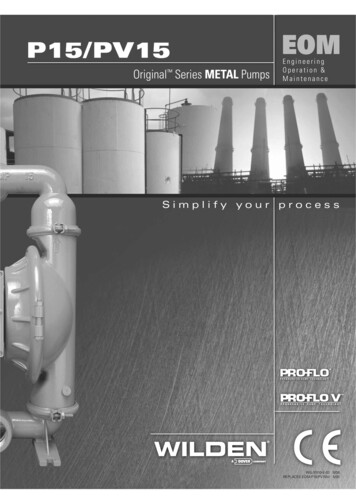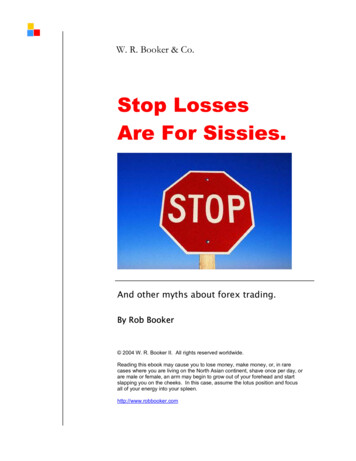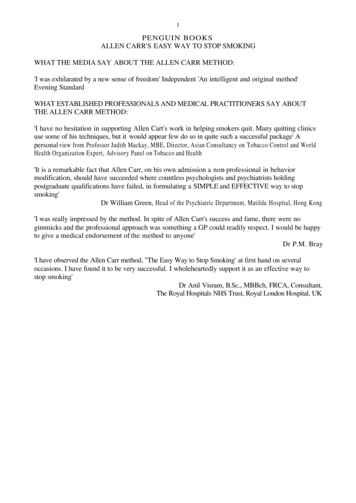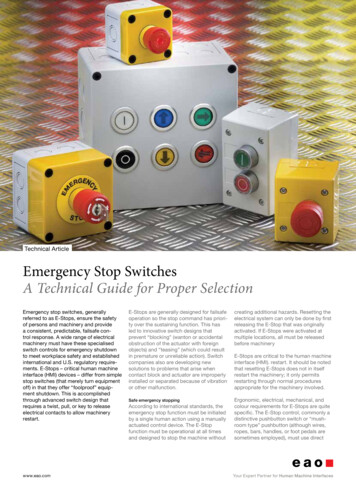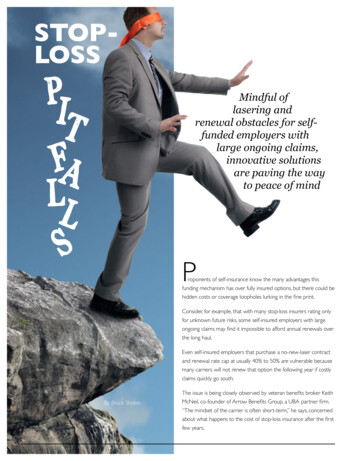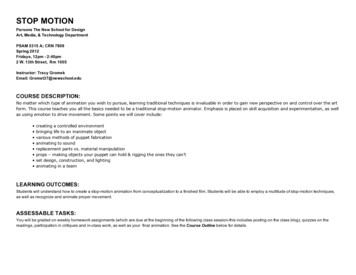
Transcription
STOP MOTIONParsons The New School for DesignArt, Media, & Technology DepartmentPSAM 5315 A; CRN 7809Spring 2012Fridays, 12pm - 2:40pm2 W. 13th Street, Rm 1005Instructor: Tracy GromekEmail: Gromet37@newschool.eduCOURSE DESCRIPTION:No matter which type of animation you wish to pursue, learning traditional techniques is invaluable in order to gain new perspective on and control over the artform. This course teaches you all the basics needed to be a traditional stop-motion animator. Emphasis is placed on skill acquisition and experimentation, as wellas using emotion to drive movement. Some points we will cover include: creating a controlled environmentbringing life to an inanimate objectvarious methods of puppet fabricationanimating to soundreplacement parts vs. material manipulationprops – making objects your puppet can hold & rigging the ones they can’tset design, construction, and lightinganimating in a teamLEARNING OUTCOMES:Students will understand how to create a stop-motion animation from conceptualization to a finished film. Students will be able to employ a multitude of stop-motion techniques,as well as recognize and animate proper movement.ASSESSABLE TASKS:You will be graded on weekly homework assignments (which are due at the beginning of the following class session-this includes posting on the class blog), quizzes on thereadings, participation in critiques and in-class work, as well as your final animation. See the Course Outline below for details.
COURSE OUTLINE:WEEKDATE11/27TOPICBRING THESE MATERIALSTO CLASSIntroduction to the CourseHOMEWORK!!!!22/03Found Object Tool Box!!!32/10Paper & Sound Tool Box variety of colored paper(i.e., coloraid, paintswatches, constructionpaper)!!!Animation:" perform a ‘magic trick’ on 1s" perform the same ‘magic trick’ on 2s" use ease in/out and vary your timing and spacingReadings:" ease in/ease out" timing and spacing" 1s vs 2sBlog" register with me to post on the class blog" post your personal introduction" post your magic trick animations with reflection/analysisOther" purchase supplies & Williams’ The Animator’s Survival Kit" determine the technology you will use to capture your weeklyhomework. Solve any bumps THIS WEEK." install animation capture software on your computer" watch DragonFrame tutorials onlineAnimation:" create a 10 second animation from found objects around your home.Objects must be used to create a different object." use ease in/out, vary timing and spacing, concentrate on weight andgravityReadings:" weight" gravityBlog" post your found object animation with reflection" check out inspirational animations onlineAnimation:" create a 10 second animation to the score of your choice using onlycolored paper" you may only use one shape but can vary the size of the shapethroughout the animation" storyboard before you start animating" read your sound to a dope sheetReadings:" timing and planning" line of action, balanceBlog" post your color block animation, storyboard, dope sheets, andreflection
42/17Clay Tool Box Clay Items 2 colors of van aken clay!!!52/24Strata-Cut Tool Box Clay Items at least 4 colors and 4 lbsof van aken clay!!!63/2Pixilation still or video camera (if youhave it - iphone or androidwill work, too, but a camerawith a changing lens wouldbe nicer.)!!!73/9Group Animation:Part 1: Tool Box Puppet Items!Intro to Group Project &Building Armatures!!!Animation:" create a 10 second animation to the word of your choice (list given inclass and posted on blog) using 4 colors of clay" storyboard before you start animatingReadings:" squash & stretch" overlap & follow throughBlog" post your clay animation, storyboard, and reflectionAnimation:" create a 5 to 10 second strata-cut animation. Transition from onefacial expression to another. Make it big!Readings:" expressionBlog" post your strata-cut animation and reflectionAnimation:" 15 second animation using a person or a group of people as themain focus of the piece.Readings:" lip sync" acting/emotion/creating a sceneBlog" post your pixilation animation and reflectionAnimation:" 10 second animation of your puppet coming to life. This must befilmed straight on - no top down animation!" each move your puppet makes should be deliberate" fix your puppet if it breaks or build a new oneReadings:" movement of two legged figures" timing a walk" replacement parts" storyboardingGroup Work" finalize story" finalize storyboard" finalize visual design (puppets, set, props - remember, joints need tomove!)" determine who will bring what to each class" designate group bloggerBlog" post your armature coming to life animation with reflection" one person from your group needs to post:#the story breakdown#storyboard# puppet sketches
!---3/16SPRING BREAKNO CLASS83/23Group Animation:Part 2:Rigging and DecoratingPuppets, Building Props93/30Group Animation:Part 3:Continue working on last week’s homework Tool Box Puppet Items any materials you mayneed to decorate yourpuppet or create props.These may include:- fabric- yarn- nylon- filling- foam- foam core- super sculpey- paint- resin- silicone- plastic" Tool Box materials needed for set(i.e., cardboard, foam core)""""Set Construction"104/6Group Animation:Part 4:Animation on Set114/13Special Effectslist of what is needed to complete the animation and who isresponsible for each item Tool box with Puppet Itemsadded lights"" clamps tripod camera way to capture withouttouching the camera" Tool Box with"Readings:# actingGroup Work# finish puppets# finish props# finalize any set changes# designate group bloggerBlog# one person from your group needs to post:! pictures of your finished puppets and props! sketches showing any changes to sets! reminder of who is bringing what to class next weekReadings:# lightingGroup Work# finish sets# start animating# designate group bloggerBlog# one person from your group needs to post:! pictures of your finished puppets and props! sketches showing any changes to sets! reminder of who is bringing what to class next weekReadings:# lightingGroup Work##Blog##finish animationdesignate group bloggerone person from your group needs to post the final animationeach person in the group must post their own reflection and link thatpost to their group’s final animation postAnimation:
teIntro to FinalSand Items andPaint-on-GlassItems added light box (may have inschool) or make your own pane of glass or plexi-glassfor your group way to contain sand onyour group’s glass pane(foam core or cardboardsides) Tool Box with Cut-OutItems added!"""""134/27Work on Finalanything you may need towork on your final in class""145/4Work on Finalanything you may need to"work on your final in class""155/11Final PresentationDVD of all your work fromthis semester (including yourfinal)chose one of the animation types we explored this week and createa 10 second animationReadings:! mold making & casting! timing for water, smoke, & fiireBlog! post your animation and reflectionAnimation:! animate a 10 second cut-out sequence using the puppet youcreated in class, or a new puppet of your choosing! storyboard first! don’t forget about emotion! What is driving your character to do whathe is doing?Readings:! mold making & casting! timing for water, smoke, & fireBlog! post your animation and reflection! post info on your final# at least three precedence# describe your story in two sentences# storyboard# music of choiceAnimation:! work on finalBlog! post your animation to date and reflectionAnimation:!Blog!Other!continue working on finalpost your final animation and reflectionput all of your work from this semester onto a DVD to hand in nextweek
THE CLASS BLOG:www.StopMotionAtParsons.Wordpress.comGETTING ACCESSIn order to be authorized to post on the blog, you must do two things:1. create a wordpress account2. send me the email address you used to create your wordpress account. (My email address is gromet37@newschool.edu.)You will get a confirmation email from me stating you are now an authorized user as soon as I authorize your account.PERSONAL INTRODUCTION BLOG POST:Please introduce yourself to the class by following the below format:Title of Post : Intro to (Your Name)! your nickname or what you would like to be referred to in class as! photo of yourself! animation experience:! acting experience:! I took this class (because, so that).! The animation that has had the strongest impact on me is (link to a clip if possible) because .WEEKLY REFLECTION:Each week you are to post your animation along with a reflection onto the class blog. This reflection allows both you and me to see where you are succeeding and makingprogress, as well as catch any issue that may arise early on, addressing it before it gets out of control. Please post prior to class, not during. (The night before is best so that I canreview your work prior to class.) The weekly reflection format is as follows:Title of Post: Week #X: Animation Type by First Name Time to Build: Time to Animate: Problems encountered: Aha moment: If I animated this again I would:tag post with appropriate week #WEEKLY REFLECTION EXAMPLE:Week #5: Strata-cut by Tracy Time to Build: 8hrs Time to Animate: 30 minutes Problems encountered: I was having a really hard time building the structure. I couldn’t really wrap my brain around what was happening in thecenter of the piece of clay. As such, I had to rebuild the structure 3 times before it finally came out right. Also, I started cutting the pieces of clay off waytoo thick in the beginning. There was no ease out of the image and the transformation seemed very rushed at the beginning. Aha moment: On the third time building the structure I decided to draw out what needed to happen. For some reason, drawing the sculpture firstmade it much easier for me to understand the 3-dimensional structure and how it would change over time. If I animated this again I would: Sketch out the beginning and end points and then connect them before I even pick up clay!week #5
MATERIALS LIST:**Links to certain items that are hard to find, unusual, or my particular favorites are posted on the class blog. (StopMotionAtParsons.Wordpress.com)ITEMS DEFINITELY NEEDED:the school lab has all of these items, but if you want to work at home you’ll need: camera with manual focus capture software ability to take an image without directly touching the camera (cable release or connection to your computer) tripod lights (can be cheap home depot set up or expensive light kit from the 10th floor lab)ANIMATOR’S TOOL BOXA stop-motion animator should always have certain tools with her when she starts to animate. All too often something needs to be rigged or built before you can continue on withan animation. Having a well stocked tool box will help to alleviate many issues that will arise pre- & during production. You can add and subtract certain items depending on thetype of animation on which you are embarking. Items with (R) are repeats from previous sections.Your Animator’s Tool Box should ALWAYS CONTAIN: tweezers tacky wax** x-acto & plenty of extra blades straight edge fishing wire needle nose pliers wire cutters hot glue gun & glue sticks stick of plumbers epoxy** (5 minute quick dry, not the liquid) and plasticgloves if you are worried about touching the epoxy with bare hands - it is acarcinogen armature wire** a variety of scissors (nail scissors, thread scissors, normal sized scissors) push up glue stick** paint brushes (various types used to paint and create texture) toothpicks straight pins with flat tops q-tips small spray bottle of glass cleaner various tapes (masking, painters, gaffer’s) carpenter’s knife w/ extra blades small pieces of foam coreITEMS TO ADD to your Animator’s Tool Box when working with PUPPETS: dental tools (if you have them)** rubber clay shapers ** scraping tools** wing nuts, bolts, flat machine screws** medical tape - silk K&S aluminum tubing in variety of sizes** K&S cutter** armature wire** 1/16” gauge; at least 60’ wire mesh** beads** acrylic paint paper towels goop hand cleaner** balsa foam block or upholstery foam** carving tools if using balsa foam small earth magnets or other strong magnets (1/4” diameter or smaller) fabric scraps & bits cup for water clear nail polish small lump of throw away clay thread sewing needles fabric glue snaps, buttons, hooks
ITEMS TO ADD to your Animator’s Tool Box when working with CLAY:ITEMS TO ADD to your Animator’s Tool Box when working with CUT-OUTS: dental tools (if you have them)** (R) rubber clay shapers ** (R) scraping tools** (R) acrylic paint (R) paper towels (R) goop hand cleaner (R) mineral oil (can be found at a pharmacy - it is a laxative) sponge (any type will do) van aken clay** film container or other small cup for mineral oilITEMS TO ADD to your Animator’s Tool Box when working with PAINT-ON-GLASS: variety of colored paper** in varying thicknesses thread to match paper sewing needles (R) acrylic paint (R) chalk hole punch - 2 sizesITEMS TO ADD to your Animator’s Tool Box when working with SAND-ON-GLASS: acrylic paint (R) vegetable oil paint palette palette knife paper towels (R) cup for water (R) clear acetate sheets to cover the glass plane sand (a few pounds) clear acetate sheets (R) things to manipulate sand (i.e., sticks)SOFTWARE LIST:Links to software are posted on the class blog. (StopMotionAtParsons.Wordpress.com)READING LIST:Links to these as well as other books are posted on the class blog. (StopMotionAtParsons.Wordpress.com)REQUIRED READING:Williams, Richard. The Animator’s Survival Kit. London: Faber and Faber Limited, 2001.RECOMMENDED READING:Whitaker, Harold and Halas, John. Timing for Animation. New York: Elsevier, 2009.Hooks, Ed. Acting for Animators. Portsmouth: Heinemann, 2003.OTHER BOOKS:Webster, Chris. Animation: The Mechanics of Motion. Burlington: Focal Press, 2009.Blair, Preston. Cartoon Animation. Laguna Hills: Walter Foster Publications, Inc., 1994.Purves, Barry J C. Stop Motion: Passion, Process and Performance. Burlington: Focal Press, 2007.Lord, Peter and Sibley, Brian. Creating 3-D Animation: The Aardman Book of Filmmaking. New York: Harry N. Abrams, Inc.Shaw, Susannah. Stop Motion: Craft Skills for Model Animation. 2nd Ed. New York: Focal Press, 2008.
Thomas, Frank and Johnston, Ollie. The Illusion of Life Disney Animation. New York: Walt Disney Productions, 1981.Stanchfield, Walt. Drawn to Life. Burlington: Focal Press, 2009.Spess, Marc. Secrets of Clay Animation Revealed. CreateSpace, 2000.White, Tony. Animation from Pencils to Pixels: Classical Techniques for Digital Animators. Burlington: Focal Press, 2006.Gonick, Larry and Huffman, Art. The Cartoon Guide To Physics. New York: Harper Perennial, 1991.Wells, Paul. Understanding Animation. New York: Routledge, 1998.EVALUATION and GRADINGStop Motion meets on Fridays from 12 - 2:40 pm in the back of the 10th floor lab, room 1005. A minimum of 10 hours of work per week outside of the classroom is expected fromeach student. As per University policy, 3 absences constitute grounds for failure. (That means you can only miss two classes - on the third absence you fail the course.) Twoabsences will result in an automatic academic warning. If you miss a class, it is your responsibility to find out what was covered and come to the next class prepared to showhomework from the week missed as well as due for that day.Students will be graded on:40% homework (delivered on time, uploaded before the start of class at 12 pm, and completed)5% quizzes15% in-class work15% critique participation25% FinalTotal 100%Graduate Grade Scale Descriptions!!!!!!!!A: Work of exceptional qualityA-: Work of high qualityB : Very good workB: Good work; satisfies course requirementsB-: Below averageC : Less than adequateC: Well below average; lowest possible passing gradeF: Failure, no creditACADEMIC INTEGRITY & HONESTYAcademic honesty, the duty of every member of an academic community to claim authorship of his or her own work and only for that work and to recognize the contributions of others accurately andcompletely, is fundamental to the integrity of intellectual debate and creative and academic pursuits. All members of the University community are expected to conduct themselves in accord with thestandards of academic honesty. Students are responsible for knowing and making use of proper procedures for writing papers, presenting and performing their work, taking examinations, and doingresearch. Instructors are equally responsible for informing students of their policies with respect to the limits within which students may collaborate with or seek help from others on specificassignments. Instructors are expected to educate students about the legal and ethical restrictions placed upon creative work and about the consequences of dishonesty in the professional world. AtParsons, all students are required to sign an Academic Integrity Statement declaring that they understand and agree to comply with this policy.(From the University Policies Governing Student Conduct)“Academic honesty includes accurate use of quotations, as well as appropriate and explicit citation of sources in instances of paraphrasing and describing ideas, or reporting on research findings orany aspect of the work of others (including that of instructors and other students).
The standards of academic honesty and citation of sources apply to all forms of academic work (examinations, essay theses, dissertations, computer work, art and design work, oral presentationsand other projects).The standards also include responsibility for meeting the requirements of particular courses of study.The New School recognizes that the different nature of work across the divisions of the University may entail different procedures for citing sources and referring to the work of others. Particularacademic procedures, however, are based in universal principles valid in all divisions of the New School and institutions of higher education in general.”Academic dishonesty includes but is not limited to:!cheating on examinations, either by copying another student’s work or by utilizing unauthorized materials.!any act of plagiarism, that is, the fraudulent presentation of the written, oral or visual work of others as original.!theft of another student’s work.!purchase of another student’s work.!submitting the same work for more than one course.!destruction or defacement of the work of others.!aiding or abetting any act of dishonesty.!any attempt to gain academic advantage by presenting misleading information, making deceptive statements or falsifying documents.Guidelines for Written AssignmentsPlagiarism is the use of another person's words or ideas in any academic work using books, journals, internet postings, or other student papers without proper acknowledgment. For furtherinformation on proper acknowledgment and plagiarism, including expectations for paraphrasing source material and proper forms of citation in research and writing, students should consult theChicago Manual of Style (cf. Turabian's A Manual for Writers of Term Papers, Theses and Dissertations. 6th ed. Chicago: University of Chicago Press, 1996). The New School University WritingCenter also provides useful on-line resources to help students understand and avoid plagiarism. See html. Students must receive prior permissionfrom instructors to submit the same or substantially overlapping material for two different assignments. Submission of the same work for two assignments without the prior permission of instructors isplagiarism.Guidelines for Studio AssignmentsWork from other visual sources may be imitated or incorporated into studio work if the fact of imitation or incorporation and the identity of the original source are properly acknowledged. There must beno intent to deceive; the work must make clear that it emulates or comments on the source as a source. Referencing a style or concept in otherwise original work does not constitute plagiarism. Theoriginality of studio work that presents itself as “in the manner of” or as playing with “variations on” a particular source should be evaluated by the individual faculty member in the context of a critique.Incorporating ready-made materials into studio work as in a collage, synthesized photograph or paste-up is not plagiarism in the educational context. In the commercial world, however, suchappropriation is prohibited by copyright laws and may result in legal consequences.ProceduresAny violation of the Academic Integrity and Honesty Policy is a matter for disciplinary action.1. Initial Discussion: An instructor who suspects a student has committed plagiarism in course work should give the student an opportunity to explain the origin of the work and should investigatewhether the student understands the relevant standards of academic conduct. The instructor should explain the alleged violation clearly, concisely and specifically and should advise the student toreview the Policy in the Student Handbook.2. Follow-Up Discussion: The instructor should schedule a second meeting with the student to discuss the accusation fully following the student’s review of the Policy. Whenever possible, this fulldiscussion should take place within one week of the initial meeting.Each party may elect, but is not required, to have an impartial advisor present at the meeting. The instructor should select the Chair or Associate Chair of the program that offers the course. Thestudent should select an Advisor from the Office of Advising or from his or her program. The role of the program Chair or Associate Chair is to help facilitate discussion between the student and theinstructor by calling all parties to the meeting, providing a private meeting space and allowing the different points of view to be expressed. The role of the advisor is to help the student to understandthe Policy and the alleged violation. During the discussion, the student should be prepared to present the work in question, along with any supporting drafts, sketches, digital files or otherdocumentation. The instructor may ask the student to reconstruct the process involved in creating the work.If a violation comes to the instructor’s attention during finals or a school break, the discussion should take place as soon as possible, preferably before the start of a new semester. In this situation,the faculty member should notify his/her department and issue a temporary grade of Incomplete ("I"). In cases where the work in question is submitted at the end of the semester and/or the faculty
member is unavailable, the program Chair or Associate may elect to discuss the incident with the student.3. Assessment of Infraction: On the basis of this meeting the instructor, in consultation with the program Chair or Director, will assess the case taking into consideration the student’s intent to deceive,the amount of plagiarism, and the type of assignment involved, to determine whether a minor or major offense has occurred. The instructor who determines that a minor offense has occurred maycounsel a student about standards of academic honesty, explain the consequences of plagiarism, and require the student to resubmit the assignment in an appropriate form. An instructor whodetermines that a major offense has occurred should fail the plagiarized assignment and submit a report to the program Chair or Director and the Assistant Dean. The report should include thestudent’s name, the course, semester, notes on conversations with the student, and copies of the relevant plagiarized submission (with problems identified). Questions about the handling ofplagiarism cases should be directed to the Assistant Dean. In cases where the student is taking a course with a faculty member outside his/her division, the Dean’s Office of the faculty member willinform the Dean’s Office of the student to handle the case.4. Disciplinary Review: The Assistant Dean will issue a formal letter to the student, with a copy to the instructor, documenting the case and any imposed sanctions. A copy of this letter will remain inthe Office of Advising, the Office of Students Rights & Responsibilities, and in the student’s official file in Records.PenaltiesThe Assistant Dean may impose sanctions which can include a failing grade in the course, suspension, dismissal or expulsion. For a second major offense, the Assistant Dean will impose suspensionor dismissal. Infraction of standards of academic honesty in an M.A. or Ph.D. thesis, or in a comprehensive examination is an immediately dismissible offense. Programs should report these casesimmediately to the Assistant Dean for adjudication by an ad hoc committee convened by that office and conducted according to principles established by the division’s academic grievanceprocedures.In cases where the student confesses to the violation, the procedures and penalties for academic dishonesty may be altered at the discretion of the program Chair or Director and the Assistant Dean.Academic Integrity AppealsStudents may appeal the findings and penalties in cases of academic dishonesty to the University Appeals Committee.
" purchase supplies & Williams’ The Animator’s Survival Kit" determine the technology you will use to capture your weekly homework. Solve any bumps THIS WEEK." install animation capture software



